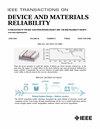Die-Attach Influence on Thermal/Electrical Parameters of GaN RF Device
IF 2.3
3区 工程技术
Q2 ENGINEERING, ELECTRICAL & ELECTRONIC
IEEE Transactions on Device and Materials Reliability
Pub Date : 2025-04-01
DOI:10.1109/TDMR.2025.3556383
引用次数: 0
Abstract
This paper presents a comprehensive study on the relation between die-attach and thermal/electrical parameters of GaN RF devices. This correlation is investigated through Multiphysics simulations and experimental data. Particularly, thermal analysis is performed by means of Quantum Focus Instrument (QFI) Infrascope able to detect the surface temperature of the device. Then, 3-D finite element method thermal simulations are performed to support the observed heat distribution. A strong association between drain current drift and temperature escalation is demonstrated by comparing two devices with significantly different die-attaches. Particularly, we observe an increase in the drain current with increasing self-heating effects, conversely to what generally expected for thermal derating. However, this correlation is then explained thanks to the analysis of threshold voltage shift with temperature that supports the experimental evidence.贴片对GaN射频器件热/电参数的影响
本文对GaN射频器件的热/电参数与贴片之间的关系进行了全面研究。通过多物理场模拟和实验数据研究了这种相关性。特别是,通过能够检测器件表面温度的量子聚焦仪器(QFI) Infrascope进行热分析。然后,进行了三维有限元热模拟,以支持观测到的热分布。漏极电流漂移和温度升高之间的强烈关联是通过比较两个器件具有显著不同的芯片附件来证明的。特别是,我们观察到漏极电流随着自热效应的增加而增加,这与通常预期的热降额相反。然而,由于阈值电压随温度变化的分析支持实验证据,这种相关性得到了解释。
本文章由计算机程序翻译,如有差异,请以英文原文为准。
求助全文
约1分钟内获得全文
求助全文
来源期刊

IEEE Transactions on Device and Materials Reliability
工程技术-工程:电子与电气
CiteScore
4.80
自引率
5.00%
发文量
71
审稿时长
6-12 weeks
期刊介绍:
The scope of the publication includes, but is not limited to Reliability of: Devices, Materials, Processes, Interfaces, Integrated Microsystems (including MEMS & Sensors), Transistors, Technology (CMOS, BiCMOS, etc.), Integrated Circuits (IC, SSI, MSI, LSI, ULSI, ELSI, etc.), Thin Film Transistor Applications. The measurement and understanding of the reliability of such entities at each phase, from the concept stage through research and development and into manufacturing scale-up, provides the overall database on the reliability of the devices, materials, processes, package and other necessities for the successful introduction of a product to market. This reliability database is the foundation for a quality product, which meets customer expectation. A product so developed has high reliability. High quality will be achieved because product weaknesses will have been found (root cause analysis) and designed out of the final product. This process of ever increasing reliability and quality will result in a superior product. In the end, reliability and quality are not one thing; but in a sense everything, which can be or has to be done to guarantee that the product successfully performs in the field under customer conditions. Our goal is to capture these advances. An additional objective is to focus cross fertilized communication in the state of the art of reliability of electronic materials and devices and provide fundamental understanding of basic phenomena that affect reliability. In addition, the publication is a forum for interdisciplinary studies on reliability. An overall goal is to provide leading edge/state of the art information, which is critically relevant to the creation of reliable products.
 求助内容:
求助内容: 应助结果提醒方式:
应助结果提醒方式:


